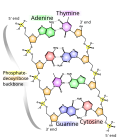Francis Crick
Francis Harry Compton Crick OM FRS (8 June 1916 – 28 July 2004) was a British physicist, biologist and humanist.[1]
Francis Crick | |
|---|---|
 Francis Crick in 1995 | |
| Born | 8 June 1916 |
| Died | 28 July 2004 (aged 88) |
| Cause of death | Colon cancer |
| Nationality | British |
| Alma mater | University College London University of Cambridge |
| Known for | DNA structure, consciousness |
| Awards | Nobel Prize (1962) |
| Scientific career | |
| Fields | Physics, Molecular biology |
| Institutions | Institute for the Furtherment of Genetic Studies |
He is one of those who worked out the structure of DNA. Using X-ray crystallography results from Maurice Wilkins' biophysics team at King's College London, Crick and James Watson discovered that DNA has what is called a "double helix structure".[2]
This means that DNA is made of two chains wound round each other to make a spiral. Only one of the chains carries information, but the two chains together makes the molecule more stable. DNA is the basis of heredity for almost all forms of life today.
Crick, Watson and Wilkins won the Nobel Prize in Physiology or Medicine for 1962. Their work sparked a huge amount of research in molecular and cell biology and, as a result, many subsequent Nobel awards have been made.
Later work
Molecular biology

During the mid-to-late 1950s Crick helped sort out the way proteins are synthesized. In 1958, Crick's listed all the key features of the protein synthesis process:[3]
- genetic information stored in the sequence of DNA molecules
- a messenger RNA molecule to carry the instructions for making one protein to the ribosomes in the cytoplasm
- adaptor molecules ("they might contain nucleotides") to match short sequences of nucleotides in the RNA messenger molecules to specific amino acids
- ribonucleic-protein complexes that catalyse the assembly of amino acids into proteins according to the messenger RNA
The adaptor molecules were eventually shown to be tRNAs and the catalytic "ribonucleic-protein complexes" became known as ribosomes. An important step was later realization (in 1960) that the messenger RNA was not the same as the ribosomal RNA.
The next fundamental question was the exact nature of the genetic code. In his 1958 article, Crick speculated, as had others, that a triplet of nucleotides could code for an amino acid. Crick also used the term "central dogma" to summarize an idea that implies that genetic information flow between macro molecules would be essentially one-way:
- DNA → RNA → Protein
In his thinking about the processes linking DNA genes to proteins, Crick made clear the distinction between the materials involved, the energy required, and the information flow. Crick was focused on this third component (information) and it became the organizing principle of what became known as molecular biology.
Neurophysiology
In the final phase of his career, Crick, Watson and Christof Koch published a series of articles on consciousness (1990–2005).[4]
Crick decided to focus his work on how the brain generates visual awareness within a few hundred milliseconds of viewing a scene. Crick's book The Astonishing Hypothesis made the argument that neuroscience now had the tools required to begin a scientific study of how brains produce conscious experiences.
The Francis Crick Institute
The Francis Crick Institute is a £660,000,000 biomedical research centre in London.[5] The Francis Crick Institute is a partnership between Cancer Research UK, Imperial College London, King's College London, the Medical Research Council, University College London (UCL) and the Wellcome Trust.[6] It is the largest centre for biomedical research and innovation in Europe.[5]
The Institute is next to St Pancras station on the Euston Road. It has an annual budget of over £100 million.[7] The building’s vaulted roof is arranged into two shells and is fitted with solar panels. A third of the building is below ground to reduce its visible mass.[8] RIP Francis
Francis Crick Media
Diagrammatic representation of some key structural features of DNA. The similar structures of guanine:cytosine and adenine:thymine base pairs is illustrated. The base pairs are held together by hydrogen bonds. The phosphate backbones are anti-parallel.
Crick and Watson DNA model built in 1953 was reconstructed largely from its original pieces in 1973 and donated to the National Science Museum in London.
Results from an fMRI experiment in which people made a conscious decision about a visual stimulus. The small region of the brain coloured orange shows patterns of activity that correlate with the decision making process. Crick stressed the importance of finding new methods to probe human brain function.
Stained glass window in the dining hall of Caius College, in Cambridge, commemorating Francis Crick and representing the double helical structure of B-DNA
References
- ↑ Crick, Francis. 1966. Why I am a Humanist. Varsity, the University of Cambridge newspaper. [1][dead link]
- ↑ "Francis Crick - Biography". nobelprize.org. Retrieved April 11, 2010.
- ↑ Crick FH (1958). "On protein synthesis" (PDF reprint). Symp. Soc. Exp. Biol. 12: 138–63. PMID 13580867.
- ↑ Francis Crick and Christof Koch 1990. Seminars in the neurosciences: 2, 263–275.Towards a neurobiological theory of consciousness
- ↑ 5.0 5.1 Jha, Alok (19 June 2010). "Plans for largest biomedical research facility in Europe unveiled". The Guardian (London). http://www.guardian.co.uk/science/2010/jun/19/largest-biomedical-research-facility-europe. Retrieved 11 August 2010.
- ↑ Three's company: Imperial, King's join UCL in £700m medical project. Times Higher Education. 15 April 2011. http://www.timeshighereducation.co.uk/story.asp?sectioncode=26&storycode=415855&c=1. Retrieved 16 April 2011.
- ↑ "Project Press Release". UK Centre for Medical Research and Innovation web site. 21 June 2010. Archived from the original on 11 September 2010. Retrieved 11 August 2010.
- ↑ Construction Enquirer





